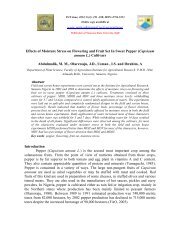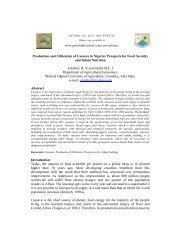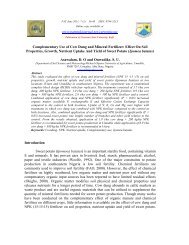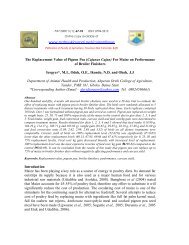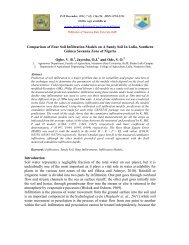Food and Feeding Habits of Protopterus Annectens (Owen ...
Food and Feeding Habits of Protopterus Annectens (Owen ...
Food and Feeding Habits of Protopterus Annectens (Owen ...
- No tags were found...
Create successful ePaper yourself
Turn your PDF publications into a flip-book with our unique Google optimized e-Paper software.
PAT December 2010; 6 (2): 69-74 ISSN: 0794-5213Online copy available atwww.patnsukjournal.net/currentissuePublication <strong>of</strong> Nasarawa State University, Keffi<strong>Food</strong> <strong>and</strong> <strong>Feeding</strong> <strong>Habits</strong> <strong>of</strong> <strong>Protopterus</strong> <strong>Annectens</strong> (<strong>Owen</strong>) (Lungfish) at Idah Area<strong>of</strong> River Niger, NigeriaADEYEMI, Samuel OlusegunDepartment <strong>of</strong> Biological Sciences, Kogi State University, P.M.B. 1008, AnyigbaE-mail: sadeyemi2003@yahoo.comTel: +2348062221968Received 30 th July, 2010, Accepted 19 th December, 2010AbstractThe food <strong>and</strong> feeding adaptations <strong>of</strong> <strong>Protopterus</strong> annectens in Idah area <strong>of</strong>River, Kogi State were studied. A total <strong>of</strong> 62 fish samples <strong>of</strong> were obtainedfrom Egah market, Idah area <strong>of</strong> river Niger, Kogi State. The samples werepurchased weekly from the fishermen from July to December 2007, examinedfresh <strong>and</strong> transported into the Biological Sciences Laboratory for analysis.Each stomach was split open <strong>and</strong> the contents emptied into a Petri-dish. Thecontents were then observed under a monocular microscope <strong>and</strong> the stomachcontents analyzed using frequency <strong>of</strong> occurrence <strong>and</strong> numerical methods. Theresult showed that P. annectens is an omnivore feeding on other fish,s<strong>and</strong>/mud, insect parts, plant parts, crustaceans, cyst, worms, detritus <strong>and</strong>some unidentified food items. The stomach fullness during the period <strong>of</strong> studycould be attributed to food abundance <strong>and</strong> good feeding habit.Keywords: Lungfish, stomach content, feeding habit.IntroductionFish must exploit food in aquatic environment <strong>and</strong> the adaptation for these is source <strong>of</strong>some morphological traits related to feeding. Underst<strong>and</strong>ing the relationship betweenbody structures <strong>and</strong> fish diet could be important for predicting the diet <strong>of</strong>, how they feed<strong>and</strong> the mechanics <strong>of</strong> feeding. sStudies on stomach composition could provide usefulinformation in positioning <strong>of</strong> the fishes in a food web in their environment <strong>and</strong> informulating management strategy options in multi species fisher (Joseph <strong>and</strong> Djama,1994). Pius <strong>and</strong> Benedicta (2002) reported the use <strong>of</strong> stomach content results to reduceintra <strong>and</strong> inter specific competition for ecological niche. The data on stomachcomposition <strong>of</strong> fish is vital in providing models <strong>of</strong> stomach content dynamics (Palmoreet al 1997).<strong>Protopterus</strong> annectens commonly known as African lungfish is the only specie <strong>of</strong>primitive family Lepidosirenidae found in West African fresh waters (Reed et al 1967).
PAT 2010; 6 (2): 69-74 ISSN: 0794-5213;. Adeyemi, S. O: <strong>Food</strong> <strong>and</strong> <strong>Feeding</strong> <strong>Habits</strong> <strong>of</strong> <strong>Protopterus</strong> <strong>Annectens</strong> … 71Stomach Contents Analysis: Each stomach was split open <strong>and</strong> the contents emptiedinto a Petri-dish. The contents were then observed under a monocular microscope. Thefood materials were identified with the aid <strong>of</strong> keys provided by Needham <strong>and</strong> Needham(1962) <strong>and</strong> Mellanby (1975).The stomach contents were analyzed by frequency <strong>of</strong> occurrence method as describedby Hynes (1950). Each food item was identified <strong>and</strong> number <strong>of</strong> stomachs in which eachfood occurred was counted <strong>and</strong> expressed as a percentage <strong>of</strong> stomach containing food.The method showed the proportion <strong>of</strong> individuals eating a particular food item in aspecies. The occurrence <strong>of</strong> each food item was expressed as a percentage <strong>of</strong> all stomachwith food. That is, P = (b/a) x 100.Where, a = Total number <strong>of</strong> fish examined with food in the stomach; b = Number <strong>of</strong>fish containing a particular food item; P = Percentage <strong>of</strong> occurrence <strong>of</strong> each food item.Data Analysis: The relationship between the fish Total length (TL) <strong>and</strong> Gut length(GL) was computed using a linear regression model.GL = a + b TLWhere GL is Gut length (cm); TL is fish total length (cm); a is constant; b is exponent.Result <strong>and</strong> Discussion<strong>Feeding</strong> Adaptations: The mouth <strong>of</strong> P. annectens is relatively small <strong>and</strong> terminal forfeeding on smaller food substances in mid <strong>and</strong> open water, hence predator or prey onplanktons (Reed et al 1967; Holden <strong>and</strong> Reed, 1972).The teeth found in the species greatly <strong>and</strong> relatively to omnivorous food habits <strong>and</strong> itsprimitive compared to those found in the other species (Reed et al., 1967). The presence<strong>of</strong> razor-like bony ridge teeth (fusiform teeth) indicates that ability <strong>of</strong> P. annectens tocrack hard food substances like seeds <strong>and</strong> fruits (Reed et al., 1967).Stomach Fullness: Table 1 shows the stomach fullness <strong>of</strong> samples analyzed. Twentyfour percent (24.19%) <strong>of</strong> the sample had empty stomach while 75.8% had full stomach.This may suggest earlier stoning <strong>of</strong> the fish samples immediately after capture <strong>and</strong>active fishing methods employed. Similarly higher occurrence <strong>of</strong> non-empty stomachwere due to good feeding strategy <strong>of</strong> species <strong>and</strong> food abundance in most part <strong>of</strong> theyear (Fagade, 1978). The result <strong>of</strong> the higher fullness <strong>of</strong> stomach during the period <strong>of</strong>this work (August to November), more so, the availability <strong>of</strong> food material may be thereason for higher percentage <strong>of</strong> full stomach. The result is in line with the findings <strong>of</strong>Shinkafi <strong>and</strong> Ipinjolu (2001) on the occurrence higher percentage <strong>of</strong> Synodontis clariaswith food in July <strong>and</strong> August (Rainy season) when food was available.
PAT 2010; 6 (2): 69-74 ISSN: 0794-5213;. Adeyemi, S. O: <strong>Food</strong> <strong>and</strong> <strong>Feeding</strong> <strong>Habits</strong> <strong>of</strong> <strong>Protopterus</strong> <strong>Annectens</strong> … 72Table 1: Stomach fullness <strong>of</strong> <strong>Protopterus</strong> annectens at Idah area <strong>of</strong> River Niger,NigeriaSex 0/4(n=14)4/4(n=9)¾(n=16)½(n=14)¼(n=9)Subtotal Percentage(%) totalAF 0.36 0.22 0.19 0.14 0.43 1.34 26.91AM 0.21 0.33 0.25 0.21 0.14 1.14 22.89Gr<strong>and</strong>total0.99 0.99 1.00 1.00 1.00 4.98 100%<strong>Food</strong> Items: The frequency <strong>and</strong> numerical method result <strong>of</strong> the stomach <strong>of</strong> P.annectens is shown in Table 2. The major categories <strong>of</strong> food items found in the stomachby % frequency <strong>of</strong> occurrence includes; plant parts (24.16%), fish part (6.12%),s<strong>and</strong>/mud (33.07%), crustaceans (8.57%), insect parts (8.13%), worms (0.22%), cyst(0.11%), detritus (6.12%) <strong>and</strong> unidentified items (13.47%). While numerical methodhad the following %, plant parts (32.42%), fish part (16.35%), s<strong>and</strong>/mud (32.21%),crustaceans (4.90%), insect parts (2.79%), worms (0.73%), cyst (0.15%), detritus(4.15%), unidentified items (6.30%). Analysis <strong>of</strong> variance showed that there was nosignificant difference (P>0.05) in the stomach content based on the method used. Oniyeet al., (2006) had earlier reported the presence <strong>of</strong> insect, fish part, mollusks <strong>and</strong> seeds inthe stomach <strong>of</strong> P. annectens from Jachi dam. On the contrary Reed et al., (1967) <strong>and</strong>reported the fish to feed on frogs, mollusk, fish <strong>and</strong> seeds <strong>and</strong> concluded that the fish isa carnivore. Fish species tend to have preference for some items they consume as foodOfujekwu <strong>and</strong> Ejike (1992) reported that there is preference for a particular foodorganism in the diet <strong>of</strong> most species.Table 2: Stomach contents <strong>of</strong> <strong>Protopterus</strong> annectens using frequency <strong>of</strong> occurrence<strong>and</strong> numerical methods<strong>Food</strong> items% frequency <strong>of</strong> occurrence % Numerical methodPlant parts 24.16 32.42Fish parts 6.12 16.35S<strong>and</strong>/mud 33.07 32.21Crustaceans 8.57 4.90Insect part 8.13 2.79Worms 0.22 0.73Cyst 0.11 0.15Detritus 6.12 4.15Unidentified items 13.47 6.30
PAT 2010; 6 (2): 69-74 ISSN: 0794-5213;. Adeyemi, S. O: <strong>Food</strong> <strong>and</strong> <strong>Feeding</strong> <strong>Habits</strong> <strong>of</strong> <strong>Protopterus</strong> <strong>Annectens</strong> … 73The result obtained suggest that the species in an omnivore feeding more on plant <strong>and</strong>animal materials, s<strong>and</strong> grains <strong>and</strong> detrital matter. This deduction tallied with thefindings <strong>of</strong> Holden <strong>and</strong> Reed, (1972) who report cyst, fish parts, benthic worms, insect<strong>and</strong> detrital matter as dominant food items in the stomach <strong>of</strong> ancient <strong>Protopterus</strong>species. The result <strong>of</strong> this study showed that animal food material had higheroccurrences during the study period. This may suggest diversify food habit <strong>of</strong> thespecies because it possesses well equipped canal <strong>and</strong> bony-ridge teeth for manipulatinganimal substances (Malami et al., 2004). The non-empty stomach could be attributed t<strong>of</strong>ood abundance <strong>and</strong> good feeding habits.ConclusionThe presence <strong>of</strong> primitive feeding adaptive features in P. annectens suggest themodification <strong>of</strong> structural trait to suit omnivorous feeding habit. The stomach fullnessduring the period <strong>of</strong> study could be attributed to food abundance <strong>and</strong> good feedinghabits. The food preference <strong>of</strong> P. annectens in natural ecosystem as revealed by thestomach content may be useful in multispecies fishery management as well as aquafeed.ReferencesFagade, S.O. (1978). The food <strong>and</strong> feeding habits <strong>of</strong> Tilapia species from the Lagoslagoon. Journal <strong>of</strong> Fish Biology, 3:151 – 156.Needham, P.R. <strong>and</strong> J.G. Needham (1962). A guide to the study <strong>of</strong> freshwater biology. 5 thedition Holden Day Inc. LondonHolden, M. <strong>and</strong> W. Reed (1972). West African Fresh water Fishes West African NatureBook Longman Publications, London.Hynes, H.B.N. (1950). The food <strong>of</strong> fresh water Stickle backs (Gasterosteus acculeatus<strong>and</strong> Pygoteus pungistis) with review <strong>of</strong> methods used in studies <strong>of</strong> the food <strong>of</strong>fishes. Journal <strong>of</strong> Animal Ecology 19:36 – 58Ipinjolu, J.K., G.Z. Malami, W.A. Hassan <strong>and</strong> I. Magawata (2004). Gut systems <strong>of</strong>some fresh water fish species in River Rima Northern Nigeria. A paperpresented at the 2004 Annual Conference <strong>of</strong> Zoological Society <strong>of</strong> Nigeria, heldat Institute <strong>of</strong> Development Research, Ahmadu Bello University, Zaria.Joseph, Y.J. <strong>and</strong> T. Djama, (1994). <strong>Food</strong> habits <strong>of</strong> two sciaenid fish speciesPseudotolithus <strong>and</strong> Pseudotolithus senegalensis <strong>of</strong>f Cameroon. NAGA ICLARMQuarterly Volume 2:pp 40 – 41.Lagler, K.F., Bardach, J.E., Miller, R.R. <strong>and</strong> May Passino, D.R. (1977). Ichthyology. 2 ndEdition. Wiley <strong>and</strong> Sons Inc. printed in USA pp 129 – 163
PAT 2010; 6 (2): 69-74 ISSN: 0794-5213;. Adeyemi, S. O: <strong>Food</strong> <strong>and</strong> <strong>Feeding</strong> <strong>Habits</strong> <strong>of</strong> <strong>Protopterus</strong> <strong>Annectens</strong> … 74Malami, G.Z., J.K. Ipinjolu, W.A. Hassan <strong>and</strong> I. Yaro (2004). <strong>Feeding</strong> Adaptations <strong>of</strong>ten fish species in River Rima North Western Nigeria. A paper presented at the2004 Annual Conference <strong>of</strong> Zoological Society <strong>of</strong> Nigeria, held at Institute <strong>of</strong>Development Research, Ahmadu Bello University, Zaria pp1 – 13Mellanby, H. (1975). Animal Life in Freshwater. A guide to Freshwater Invertebrates6 th ed. Chapman <strong>and</strong> Hall, LondonOfojekwum, P.C. <strong>and</strong> Ejike, C. (1992). <strong>Food</strong> composition <strong>and</strong> feeding habits <strong>of</strong>Oreochromis niloticus in Panyam Fish Farm, Nigeria. Journal <strong>of</strong> AquaticScience, 7:13 – 17Olatunde, A.A. (1979). The food <strong>and</strong> feeding habits <strong>of</strong> Eutropius niloticus (Ruppel),Family Schilbeidae (Osteichthys:Siluriforms) in Lake Kainji. Hydrobiologia,57:197 – 203Oniye, J.S., Adebote, D.E., Usma, S.K. <strong>and</strong> Makpo, J.K. (2006). Some aspect <strong>of</strong> thebiology <strong>of</strong> <strong>Protopterus</strong> annectens in Jachi Dam near Katsina, Katsina StateNigeria. Journal <strong>of</strong> Fisheries <strong>and</strong> Aquatic Science, 1(2):136 – 141,2006.Palmores, M.L.D, L.R. Garces, Q.P. Sia II <strong>and</strong> M.J.M. Vega (1991). Diet composition<strong>and</strong> daily ration estimates <strong>of</strong> selected trawl caught fishes in San Miguel bay,Philippines NAGA, the ICLARM Quarterly Vol. 2 pp 35 – 40.Pius, M.O. <strong>and</strong> O.O. Benedicta (2002). <strong>Food</strong> <strong>and</strong> feeding inter-relationship. Apreliminary indicator to the formulation <strong>of</strong> the feed <strong>of</strong> some Tilapine fishes.Tropical Journal <strong>of</strong> Animal Science, 5(1):35 – 41Reed, W., J. Burchard, A.J. Hopson, J. Jennes, I. Yaro (1967). Fish <strong>and</strong> Fisheries <strong>of</strong>Northern Nigeria. 1 st Ed. Ministry <strong>of</strong> Agriculture, Northern Nigeria. 226pShinkafi, B.A. <strong>and</strong> Ipinjolu, J.K. (2001). <strong>Food</strong> <strong>and</strong> feeding habits <strong>of</strong> catfish, Synodontisclarias (Linneaus) in River Rima, Nigeria. Journal <strong>of</strong> Agriculture <strong>and</strong> Environment2(1):104 - 120




